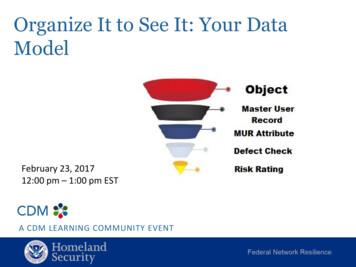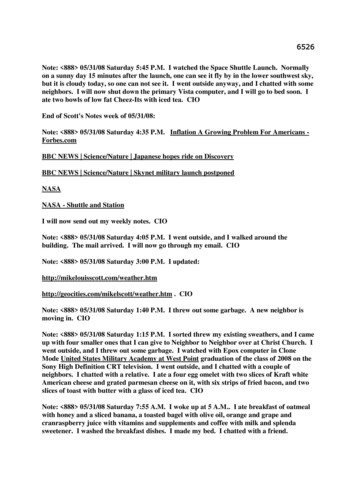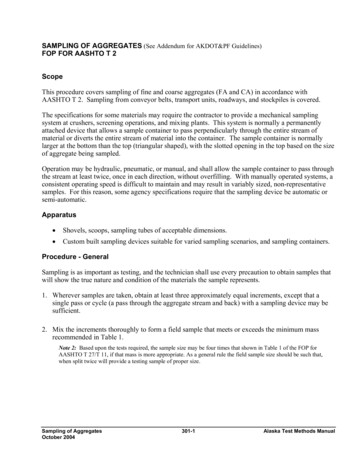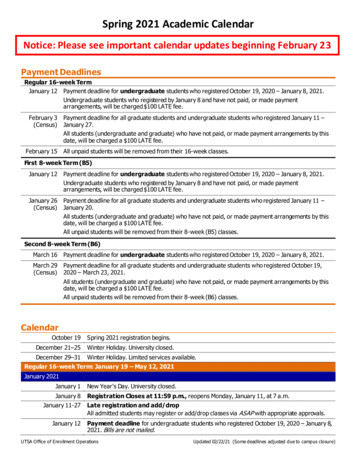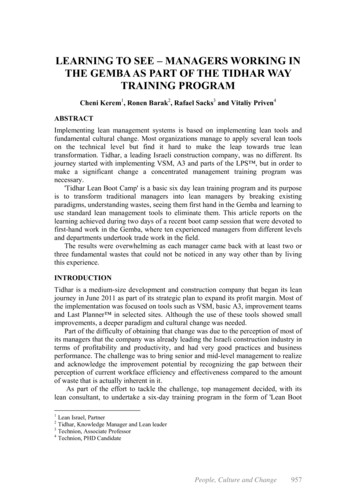
Transcription
LEARNING TO SEE – MANAGERS WORKING INTHE GEMBA AS PART OF THE TIDHAR WAYTRAINING PROGRAMCheni Kerem1, Ronen Barak2, Rafael Sacks3 and Vitaliy Priven4ABSTRACTImplementing lean management systems is based on implementing lean tools andfundamental cultural change. Most organizations manage to apply several lean toolson the technical level but find it hard to make the leap towards true leantransformation. Tidhar, a leading Israeli construction company, was no different. Itsjourney started with implementing VSM, A3 and parts of the LPS , but in order tomake a significant change a concentrated management training program wasnecessary.'Tidhar Lean Boot Camp' is a basic six day lean training program and its purposeis to transform traditional managers into lean managers by breaking existingparadigms, understanding wastes, seeing them first hand in the Gemba and learning touse standard lean management tools to eliminate them. This article reports on thelearning achieved during two days of a recent boot camp session that were devoted tofirst-hand work in the Gemba, where ten experienced managers from different levelsand departments undertook trade work in the field.The results were overwhelming as each manager came back with at least two orthree fundamental wastes that could not be noticed in any way other than by livingthis experience.INTRODUCTIONTidhar is a medium-size development and construction company that began its leanjourney in June 2011 as part of its strategic plan to expand its profit margin. Most ofthe implementation was focused on tools such as VSM, basic A3, improvement teamsand Last Planner in selected sites. Although the use of these tools showed smallimprovements, a deeper paradigm and cultural change was needed.Part of the difficulty of obtaining that change was due to the perception of most ofits managers that the company was already leading the Israeli construction industry interms of profitability and productivity, and had very good practices and businessperformance. The challenge was to bring senior and mid-level management to realizeand acknowledge the improvement potential by recognizing the gap between theirperception of current workface efficiency and effectiveness compared to the amountof waste that is actually inherent in it.As part of the effort to tackle the challenge, top management decided, with itslean consultant, to undertake a six-day training program in the form of 'Lean Boot1Lean Israel, PartnerTidhar, Knowledge Manager and Lean leader3Technion, Associate Professor4Technion, PHD Candidate2People, Culture and Change957
Cheni Kerem, Ronen Barak, Rafael Sacks and Vitaliy PrivenCamp' for managers from every level. The highlight of the program was two full daysof work in the Gemba, during which the managers had to work as professional tradeworkers.In this paper, the authors adopt the role of reflective practitioners. The aim is toshare knowledge and experience with the Lean Construction community in order tocontinuously improve their implementation, both through reflection and bystimulating feedback from the community.BACKGROUNDORGANIZATIONAL/CULTURAL CHANGEIn a 2009 article, John Shook described how the failing factory of NUMMI changedits culture under the management of Toyota (Shook 2009). He claimed that thechange model was similar to the one developed by the leading MIT researcher, EdgarSchein, who distinguished between three levels in every organizational culture: thelevel of its artifacts, the level of its espoused beliefs and values, the level of its basicunderlying assumptions (Schein 2006). According to Shook, trying to convincepeople to change their mind about their underlying assumption is useless and createsstrong resistance to change. The only way to change the underlying assumptions isby changing the behaviors or artifacts. The key success factor in NUMMI, was thatthe new management did not try to influence directly on the underlying assumptions,but on the first level of behavior. The culture changed as a result.Taking Tidhar's managers to the Boot Camp workshop aimed to change theirbehaviors, so that they could become the "wheels of change" for the organizationallean transformation.GEMBA IN LITERATURE; HOW HAS IT BEEN USED; WHY IS IT EFFECTIVEThe Japanese word "Gemba" means the real or actual place, and lean practitioners useit to refer to the actual place where value is created. The principal of "genchigembutsu"- the commitment to seeing things (gembutsu) first hand as they really arein the workplace (gemba or genchi) - was fundamental to Taichi Ohno's approach.Among Toyota's veterans, there were many stories about the famous Ohno Circle.The idea is based on the belief that you can understand everything that is important ina process, by standing and observing from a good spot in the workplace (Shook 2009).Liker (2003) describes an interview with a senior Toyota executive, Mr. Minoura,about his personal experience in practicing Mr. Ohno's circle. According to Minoura,Ohno asked him to draw a circle on the floor of the plant and told him to "stand in thecircle, watch the process" and think for himself during the whole day.Womack described the "Gemba Walk" as a management practice to grasp thesituation before taking an action (Womack 2011). He claimed that Gemba walks arecrucial as organizations are managed and built in a vertical and complex manner,while value flows horizontally across departments or organizations to customers.Most of the managers look toward the top for direction, but value is created at thebottom where the actual work is done. A Gemba walk following the value streamcould help managers to reconcile the horizontal view with the vertical view.958Proceedings IGLC-21, July 2013 Fortaleza, Brazil
Learning to see – managers working in thegemba as part of the tidhar way training programUSE OF GEMBA IN THE CONSTRUCTION INDUSTRYThe importance of connecting managers to the workface is a well-known concept inthe construction industry. However, in the entire IGLC paper database (IGLC 2013)the keywords 'workface' and 'Gemba' appear only four times in paper titles. In theLean Construction Journal there is only one paper dealing with Gemba (Samudio et al.2011). Most of these papers discussed the connections of the site managers such asproject managers, project engineers, sub-contractors and logistics personnel, and onesuggested using "Go to Gemba" as a research method (Olatunji 2008). No paperswere found in the lean construction literature in which the Gemba approach was usedto train high-level managers and/or nor did any report on establishing the approach asa daily practice.WHAT IS BOOT CAMP?Lean Leadership Boot Camp is a special training program designed to transformtraditional leadership behaviors into behaviors centered on lean principles. Whilemany lean initiatives are based on adopting the right tools, the purpose of the LeanLeadership Boot Camp is to train leaders in the organization in the deeper level ofprinciples allowing them better implement the right tools. This is mainly done byfocusing on the understanding of the 12 paradigms of a lean leader, which are basedon Toyota principles as revealed in The Toyota Way (Liker 2003), and then teachingseveral key lean tools that support standard work. The workshop is based on a mix oftheoretical sessions, simulations and on site experience in order to ensure a profoundunderstanding of the principles. In order to keep the positive momentum of theworkshop, each participant is required to make his own improvement plan for 30-6090 days. Follow-up meetings are set in advance in order to ensure that the full plando-check-act (PDCA) cycle is kept.METHODBOOT CAMP PROGRAMThe original boot camp program was planned to span seven consecutive days. Due tomanagers' schedule overload it was decided to shorten it to six days in total spreadover three weeks (i.e. two days each week). The six days were divided as follows: thefirst two days were dedicated to learning lean principles such as waste and the 12paradigms. During these days, to emphasize understanding some of the principles, theparticipants took part in the LEAPCON simulation (Sacks et al. 2007). At the endof the first day, a first Gemba walk was scheduled, in which the group visited one ofTidhar's construction sites. The second week was dedicated entirely to Gemba work.Each of the managers undertook trade work in the field such as formwork, rebarfixing, plastering, tiling, storekeeper, electrical and plumbing finishes. During thesetwo days the managers were instructed to be common workers, meaning doing theactual work (not stand as observers) as instructed and without commenting on it orchanging it. The last two days were divided between learning lean tools and preparingpersonal improvement work plans to implement them. Among the tools where 5S,SOE (Sequence of Events), Last Planner System , visual management, Takt and theimprovement kata. To practice the SOE tool another Gemba visit took place, wherePeople, Culture and Change959
Cheni Kerem, Ronen Barak, Rafael Sacks and Vitaliy Priventhe participants were divided to three groups and each group prepared detailed SOEs.To ensure the full attention of all participants and to make sure they weredisconnected from their daily project management chores, the boot camp was held ina conference room away from the projects and the company headquarters.Furthermore, all participants had to deposit their computers and mobile phones(Figure 1) for the duration of the whole program (except during breaks and lunch).Figure 1 -Mobile phones deposit boardLEARNING TO SEE WASTESLean thinking is different from other operational excellence methodologies, such asSix Sigma, Theory of Constraints (TOC) (Goldratt 1997) and others, in putting mostof its attention in eliminating waste in order to increase value. For most managers thisis not trivial since they are used to focusing on improving value adding activities.In order to change the participants' points of view, they were first introduced tothe notion that in most activities only 10% is value adding and the rest is waste. Theparticipants then learned about the three waste categories: Muda (activities) with theeight different waste types, Mura (unevenness) and Muri (overburden). In smallsgroups they had to find examples for each of the wastes in their daily process.As mentioned earlier, to finalize the learning part, the group did their first Gembawalk to see the wastes on site. During that Gemba walk, each participant had to fillout a readymade form with examples of the eight different Muda, the Mura and Muri.The visit concluded in a group meeting to share and summarize the findings and thelessons learned. Although, the participants were highly experienced professionals,most of them only realized the amount of waste inherent in the process during theGemba walk.PREPARATIONS FOR GEMBA WORKBringing ten managers to work in the Gemba requires much preparation both of theparticipants themselves and of the workers and the managers who will host them. Thepreparation of the participants included Gemba Kata class and technical classesexplaining the type of work each of them needs to perform. The emphasis was on therequest to be a simple worker and to try not to be judgmental during the two workingdays. Each manager received the name of his Gemba manager, the name of theworker he was assigned to work with, and the working hours for the particular crew.On the Gemba side, to prepare the workers and the managers, a one hour meetingin each of the hosting projects took place. During the meeting the purpose of the bootcamp was explained, as were some basic Lean principles regarding giving respect and960Proceedings IGLC-21, July 2013 Fortaleza, Brazil
Learning to see – managers working in thegemba as part of the tidhar way training programcontinuous improvement (not all of the hosting managers were familiar with the leanmethodology and principles). The hosting managers were asked to treat the bootcamp participants as workers with no special privileges. They were instructed to givethe participants a safety brief, sign them up for special equipment and explain thedaily site routines and the actual task they needed to perform.The hosting workers were told that the managers were going to work with them asan extra pair of hand. They were asked to teach the managers the basic skills requiredfor the job and supervise them during the work execution. The workers were alsoinstructed not to give the boot camp participants any special treatment during the timethey spent with them.ACTUAL WORK IN GEMBAEach of the managers was allocated a trade during the previous week so that theyknew exactly where to go and whom to work with. The boot camp participants firstreceived a safety briefing from the site foreman and were then escorted to the mainstore to get personal safety equipment and trade specific tools. The managers thenjoined the work crew and started to work with them.The managers had to work a full day and do everything the crew did starting withthe work itself, taking breaks and cleaning their work place before leaving the site(Figure 2).(a)(b)(c)(d)Figure 2 – Managers working in Gemba: a) A project manager preparing stonecladding. b) A project manager applying plaster. c) A logistics manager fixingformwork. d) Tidhar's CEO fixing rebar.To understand the site routine and to learn as many details about the work as possible,the participants spent two full days with the same crew doing the same work. ThePeople, Culture and Change961
Cheni Kerem, Ronen Barak, Rafael Sacks and Vitaliy Privenmanagers were instructed not to take any notes during the day (they could do thatonly during breaks) so the working crews would not feel as if they were being tested.The participants were also asked not to give any suggestions or try to change the waythe crews executed their work.SUMMARY SESSIONAt the end of the second Gemba day the gro
Womack described the "Gemba Walk" as a management practice to grasp the situation before taking an action (Womack 2011). He claimed that Gemba walks are crucial as organizations are managed and built in a vertical and complex manner, while value flows horizontally across departments or organizations to customers. Most of the managers look toward the top for direction, but value is created at .

